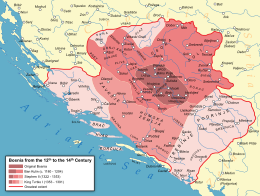Ban Kulin
| Kulin | |
|---|---|
Roman Catholicism (briefly) |

Kulin (
Early life
Kulin's sister was married to
Reign
His rule is often remembered as being emblematic of Bosnia's golden age, and he is a common hero of Bosnian national folk tales. Under him, the "Bosnian Age of Peace and Prosperity" would come to exist.[8] Bosnia was completely autonomous and mostly at peace during his rule.[9]
War against Byzantium
In 1183, Kulin Ban led his troops with the forces of the
Heresy
In 1199, Serbian prince
to Ban Kulin where they were warmly welcomed, and told him to "Go and ascertain the truth of these reports and if Kulin is unwilling to recant, drive him from your lands and confiscate his property". Kulin replied to the Pope that he did not regard the immigrants as heretics, but as Catholics, and that he was sending a few of them to Rome for examination, and also invited that a Papal representative be sent to investigate. Unconvinced, the Pope sent his legates to Bosnia to interrogate Kulin and his subjects about religion and life, and if indeed heretical, correct the situation through a prepared constitution. The Pope wrote to Bernard in 1202 that "a multitude of people in Bosnia are suspected of the damnable heresy of the Cathars." The two legates sent by the Pope went through the country of Bosnia and interrogated the clergy.Bilino Polje abjuration
Not only did Casamaris listen to his informants' answers, but where they were in error, he would have taught them correct doctrine, in line with Innocent's directive. John must have convinced himself that he had fulfilled Innocent's command to correct the krstjani, because the "Confessio" (Abjuration) signed at Bilino Polje by seven priors of the Krstjani church on 8 April 1203, makes no mention of errors. The same document was brought to Budapest, 30 April by Casamaris and Kulin and two abbots, where it was examined by the Hungarian King and the high clergy. Kulin's son.[10][11]

Charter of Ban Kulin
The Charter of Ban Kulin was a trade agreement between Bosnia and the
Death
After his death in 1204, Ban Kulin was succeeded to the Bosnian throne by
Marriage and children
Kulin married Vojislava,[15][16] with whom he had two sons:
- Ban of Bosnia
- A son that went with the Pope's emissaries in 1203 to explain heresy accusations against Kulin
Legacy and folklore
As a founder of first de facto independent Bosnian state, Kulin was and still is highly regarded among Bosnians.[17] Even today Kulin's era is regarded as one of the most prosperous historical eras, not just for Bosnian medieval state and its feudal lords, but for the common people as well, whose lasting memory of those times is kept in Bosnian folklore, like an old folk proverb with significant meaning: "Od kulina Bana i dobrijeh dana" ("English: Since Kulin Ban and those good old days").[17]
Accordingly, in today's Bosnia and Herzegovina, many streets and town squares, as well as cultural institutions, and non-governmental organizations, bear Kulin's name, while numerous culturally significant events, manifestation, festivals and anniversaries are held in celebration of his life and deeds.[18][19]
See also
- Bosnia and Herzegovina in the Middle Ages
- List of rulers of Bosnia
References
- ISBN 978-0814755617.[page needed]
- ISBN 9780791456378.
- ^ Franz Miklosich, Monumenta Serbica, Viennae, 1858[page needed]
- ^ Fine 1994, p. 19–20.
- ^ a b Stanoje Stanojević (1931). Istorija Jugoslovena: Srba, Hrvata i Slovenaca: za srednje i stručne škole. Izd. knj. Gece Kona. p. 75.
- ^ Treadgold 1997, p. 646.
- ^ a b Pejo Ćošković (2013). "Kulin". hbl.lzmk.hr (in Croatian). Hrvatski biografski leksikon. Retrieved 11 June 2022.
- ISBN 978-0814755617.
- ^ Bosnia and Herzegovina -- Britannica Online Encyclopedia Bosnia and Herzegovina: Ancient and Medieval Periods
- ISSN 1330-0474. Retrieved 15 April 2017.
- ISBN 9789024716739. Retrieved 15 April 2017.
- ^ Franz Miklosich, Monumenta Serbica, Viennae, 1858, p. 8-9.
- ISBN 9780791456378.
- ^ Emir Filipovic, twitter
- ISBN 9788683651627.
- ^ Nikola Čupić (1921). Godišnjica Nikole Čupića. Vol. 34–36. Štampa Državne štamparije Kraljevine Jugoslavije. p. 36.
Натпис нам, даље, изрично каже, да је Кулиновој жени било име Војислава.
- ^ a b "Dan kada je Kulin ban napisao Povelju" (in Bosnian). Al Jazeera Balkans. 29 August 2012. Retrieved 12 April 2017.
- ^ "Manifestacija "Od Kulina bana i dobrijeh dana"". rtvze.ba (in Bosnian). RTVZE. 7 April 2017. Archived from the original on 13 April 2017. Retrieved 12 April 2017.
- ^ "ZENICA Prigodan kulturno-umjetnički program povodom godišnjice Povelje Kulina bana" (in Bosnian). avaz.ba. Avaz. Retrieved 13 April 2017.
Further reading
- Ćirković, S. (1960). "Jedan prilog o banu Kulinu". Istorijski časopis (9–10): 71–77.
- ISBN 9781405142915.
- Ćorović, V. (1921). "Ban Kulin". Godišnjica NČ (XXXIV): 13–41.
- ISBN 0472082604.
- Marjanović, Č. (1941). "Ban Kulin i crkva bosanska: Humska kneževina i Humska episkopija". Bratstvo. Sarajevo.
- ISBN 0-8047-2630-2.
- Truhelka, Ć. (1898). "Natpis Kulina bana-[sa 2 slike u tekstu]". GZM (X). Sarajevo: 617–622.
